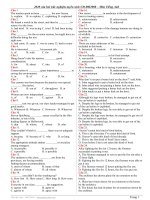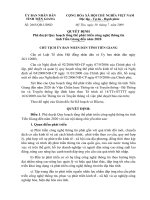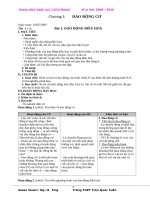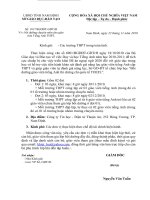2020
Bạn đang xem bản rút gọn của tài liệu. Xem và tải ngay bản đầy đủ của tài liệu tại đây (112.93 KB, 5 trang )
<span class='text_page_counter'>(1)</span><div class='page_container' data-page=1>
<b>UNIT 13: FESTIVAL</b>
<b>I.</b> <b>Grammar:</b>
<b>A. REPORTED SPEECH</b>
<b>* Direct – reported speech: (Câu trực tiếp- Câu gián tiếp)</b>
+ Câu trực tiếp: là câu nói được thuật lại đúng nguyên văn lời của người nói.
<b>Ex: Tom said, “I like reading books”. </b>
<i><b>Note: </b></i>
<i>+ Câu trực tiếp được viết trong ngoặc kép, và ngăn cách với mệnh đề tường thuật bởi dấu </i>
<i>phẩy.</i>
<i>+ Câu gián tiếp: là lời nói được thuật lại với ý và từ của người thuật nhưng vẫn giữ nguyên</i>
<i>ý.</i>
<b>Ex: Tom said he liked reading books. </b>
<i><b>Note: Câu gián tiếp không bị ngăn cách bởi dấu phẩy, dấu ngoặc kép và luôn tận cùng </b></i>
<i>bằng dấu chấm.</i>
<b>* Câu trực tiếp và câu gián tiếp bao giờ cũng gồm hai phần:</b>
- Câu tường thuật/ mệnh đề tường thuật.
- Câu trực tiếp hay câu gián tiếp.
Tom said, “I like reading books”.
MĐ tường thuật câu trực tiếp
Tom said he liked reading books.
MĐ tường thuật câu gián tiếp
<b>* Lưu ý khi chuyển từ câu trực tiếp sang câu gián tiếp :</b>
- Đổi ngơi, đổi thì, từ chỉ thời gian và nơi chốn theo quy tắc.
<b>1-Đổi ngôi:</b>
- Ngôi thứ nhất: I, me, my, mine, myself, we, us, our, ours, ourselves được đổi theo ngôi
của chủ ngữ ở mệnh đề tường thuật.
Ex: Tom said, “I like reading books”.
--> Tom said <i>he <b> liked</b><b> </b><b> reading books. </b></i>
-Ngôi thứ 2: you, yours, your, yourself, yourselves được đổi theo ngôi của tân ngữ của
mệnh đề tường thuật.
He said to me, “You can take my book”.
--> He said to me (that) I could take his book”.
Ngôi thứ 2 được đổi thành ngôi thứ 3 nếu mệnh đề tường thuật khơng có tân ngữ.
He said, “You can take my book”.
</div>
<span class='text_page_counter'>(2)</span><div class='page_container' data-page=2>
<b>-Ngôi thứ ba: he, him, his, himself, they, them, their, theirs, themselves giữ nguyên</b>
<b>Ex: Mai said, “They can’t finish their homework”.</b>
--> Mai said they couldn’t finish their homework”.
<b>2-Đổi thì:</b>
Khi chuyển từ câu trực tiếp sang câu gián tiếp ta phải lùi 1 thì :
<b>Trực tiếp</b> <b>Gián tiếp</b>
+Hiện tại đơn: V1,s,es
<b> be</b>
<b> don’t/ doesn’t +V1</b>
+Hiện tại tiếp diễn: am, is, are +V-ing
+Tương lai đơn: Will/ shall +V1
<b>+ Can/may/must </b>
-->Quá khứ đơn: V2,ed,
<b> were</b>
<b> didn’t +V1</b>
<b> </b>
-->Quá khứ tiếp diễn: was/ were + V-ing
-->Tương lai trong quá khứ : Would/
<b>should+V1</b>
- Could/might/had to
<b>3-Đổi từ chỉ thời gian, nơi chốn:</b>
Trực tiếp Gián tiếp
This
These
Here
Now
Today
Tonight
Tomorrow
Next week/ month/ year.
That
Those
There
Then
That day
That night
The next/ following day.
The following week/ month/ year.
<b>B. CÁC DẠNG CÂU TRỰC TIẾP CHUYỂN SANG CÂU GIÁN TIẾP:</b>
<b>1-Dạng câu trực tiếp </b>
<i><b>*Cách chuyển:</b></i>
-Lặp lại từ <b>said/ say.</b>
-Bỏ ngoặc kép, bỏ dấu phẩy thay bằng <b>that.</b>
</div>
<span class='text_page_counter'>(3)</span><div class='page_container' data-page=3>
<i><b>*Công thức:</b></i>
Trực tiếp: S + said, “ S + V…”
<b> -->Gián tiếp: S + said + (that) S + V(lùi thì) </b>
<b>Ex: Lan said: “I am a student”.</b>
-->Lan said (that) she was a student.
<b>2-Dạng câu trực tiếp là câu cầu khiến, câu mệnh lệnh:</b>
<i><b>*Cách chuyển:</b></i>
-Đổi động từ say-->tell, said-->told, sau đó thêm tân ngữ vào sau nó.
-Bỏ dấu phẩy, dấu ngoặc kép, dấu chấm than, từ please (nếu có).
-Đổi đại từ nhân xưng, tính từ sở hữu, trạng từ chỉ thời gian, nơi chốn (nếu cần thiết)
<i><b>*Công thức:</b></i>
+ Khẳng định: <b>Trực tiếp: S + say/ said, “V1……..”</b>
<b> -->Gián tiếp: S + tell/ told + O + to + V1…….</b>
<b> Ex: She said, “Close the books, please!”</b>
-->She told the students to close the books.
+ Phủ định: <b> Trực tiếp: S + say/ said, “Don’t + V1…….”</b>
<b> -->Gián tiếp: S + tell/ told + O + not + to + V1…….</b>
<b>Ex: She said, “Don’t sit down!”</b>
-->She told me not to sit down.
<b>II. Exercises</b>
<b>I. Change into reported speech: (Affirmative Imperatives )</b>
1. "Be a good girl and sit quietly for five minutes," the nurse said to the child.
→ The nurse told the child ………...
2.She said to the passer: “Go straight ahead for two blocks and turn left.”
→ She told the passenger ………...
3. She said to her classmate: “Be quiet, please!”
</div>
<span class='text_page_counter'>(4)</span><div class='page_container' data-page=4>
4. The teacher said to his student: “Write these sentences.”
→ The teacher told his student ………...
5. She said to me: “Behave to your parents as your friend tells you.”
→ She told me ………...…………
6. He said to us, "Run more quickly."
→ He told us ………...…………..
7.The mother said to her son, “ Move here, please.”
→ The mother told her son ………...
8.My sister said to me, “ Open the window.”
→ My sister told me ………...……
9. Minh said:” Please buy me a new book, Mom.”
→ Minh told ...
10 Hoa said to her brother “ Please help me with my homework.”
→ Hoa told her brother ...
11. I said: “Open your book , please,Miss Nga.”
→I told ...
12. Mr An said:” Please don’t make noise in class, Tom.”
→ Mr An told ...
13. “ Keep quiet during class time , Hoa” said Nam
→ Nam told ...
<b>II. Change into reported speech: (Negative Imperatives) </b>
<b>1.</b> He said to me:” Don’t make a noise.”
→ He told me ………...………..
<b>2.</b> She said to the passer-by:” Don’t turn left at the two blocks ahead.
→ She told the passer-by ………...
3.She said to her classmate:” Don’t talk in class.”
→ She told her classmate ………...
4.The teacher said to his student:” Don’t touch that new board.”
→ The teacher told his student ………...
5. She said to me:” Don’t believe everything your friend tells you.”
→ She told me ………...……….
6. He said to us, "Don't go too far."
→ He told us ………...…………
7. The mother said to her son, “ Don’t put off your coat, please.”
</div>
<span class='text_page_counter'>(5)</span><div class='page_container' data-page=5>
8.My sister said to me, “Don’t open the window.”
</div>
<!--links-->









